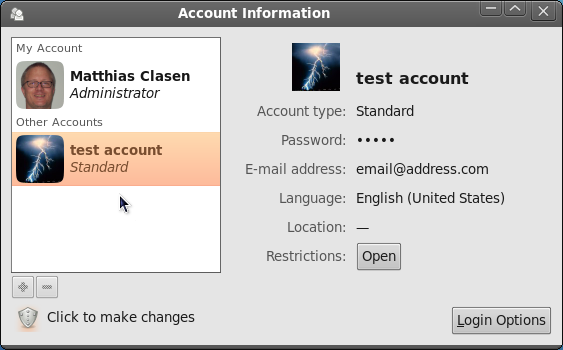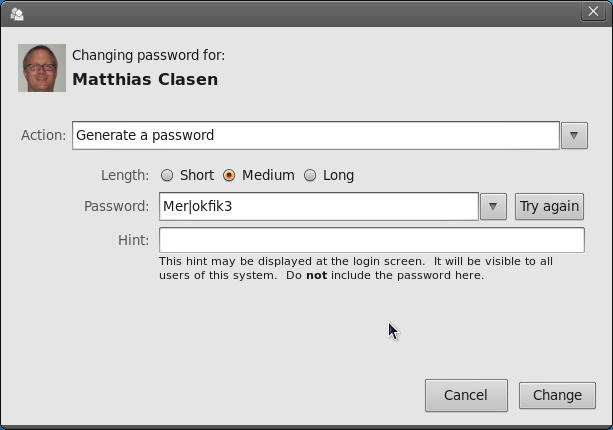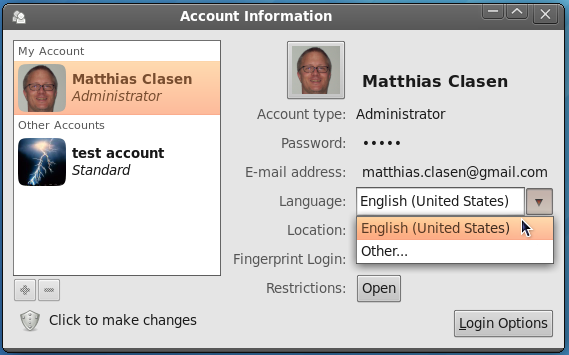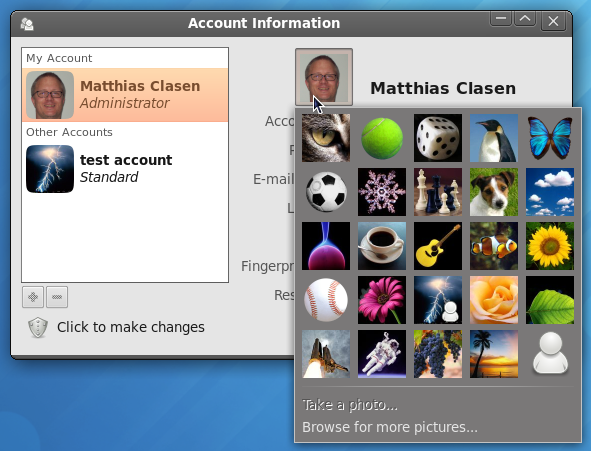User Account Dialog
Sommario
Un nuovo strumento di dialogo per creare utenti e modificare informazioni sugli utenti per sistemi mono-utenti o piccoli sistemi.
Progettista
- Nome: Matthias Clasen, Ray Strode
- Email: mclasen@redhat.com, rstrode@redhat.com
Stato corrente
- Release: Fedora 13
- Ultimo aggiornamento: 21-01-2010
- Percentuale di completamento: 40%
Il progetto nasce da idee e osservazioni che risalgono alla primavera del 2008. Di seguito si riportano le idee così come si vennero formando: [1]
- http://people.redhat.com/mclasen/user-account3.pdf.bz2
- http://fedoraproject.org/wiki/Features/ImprovedUserManagementUI: alcuni schizzi delle idee da concretizzare
- http://people.fedoraproject.org/~mccann/design/user_accounts/: alcuni file Glade
- https://www.redhat.com/archives/fedora-desktop-list/2008-May/msg00006.html: precedenti discussioni sul progetto
Ubuntu sembra stia progettando qualcosa di simile, vedi https://wiki.ubuntu.com/DesktopTeam/Specs/Lucid/UserAccountManagement
Matthias sta implementando un prototipo del progetto originale. I tarballs si trovano qu'. I repositorie Git sono questi:
Il codice, allo stato attuale, consente di modificare solo le informazioni degli utenti, non dei gruppi. La finestra di dialogo ha un'interfaccia utente per impostare le opzioni di login, ma allo stato attuale è inattiva in quanto la gdm è priva delle necessarie API. La finestra impiega l'utility apg per generare password quasi memorabili. Il servizio D-Bus usa useradd, userdel e usermod per le modifiche, e i file in /var/lib/AccountsService per conservare i dati utente che non richiedono password, come suggerimenti per buone password o foto degli utenti.
Prossimi obiettivi:
- trovare la collocazione all'interno dell'infrastruttura di progetto
- realizzare i pacchetti
- implementare le opzioni di login in gdm con le necessarie API
- integrazione: consentire p.e. ad evolution, all'applet orologio, o a gdm di recuperare i dati utente dal servizio
Detailed Description
The goal of this feature is create a single tool that allows to create new users and edit user-related information in single-user systems or small deployments. Big deployments and enterprise-level systems are not a target (we think those are better-served with a web interface for their directory server...).
The tool will (at least partially) replace the functionality of several existing components, such as system-config-users, gnome-about-me, the former gdmsetup, firstboot, the former polkit-gnome-authorization...
Use cases that we hope to cover are:
- Creating the first user when the system boots for the first time
- Editing your own account data
- User account maintenance
- Configuring the login screen
- Temporary access to the system (guest account)
The dialog will rely on a system bus service to access and store user and group data. Longer-term, the hope is that SSSDs InfoPipe can serve as the backend for this. In the short term, we need a standalone implementation, which will
- be good enough for the single-user and local scenarios
- avoid blocking on InfoPipe
- allow experiments with the API
- help with upstream acceptance
A very rough sketch of the required API could look like this:
- list cached users
- get user by uid
- get user by name
- list groups
- get group by gid
- get group by name
- create user
- delete user
- create group
- delete group
- add user to group
- remove user from group
- list groups for user
- list users for group
- user attributes: uid, name, real name, display name, home dir, shell, login frequency, locale, keyboard, email, icon, password hint, role
- group attributes: gid, name
Some of these will be privileged operations. Users will normally be allowed to set their own 'personal' data like real name, locale, keyboard, email, icon, password hint. Some of the attributes may be read-only, like uid and gid.
Listing cached users is named that way to indicate that this is not meant to be a sync call to get a list of all users, which could be prohibitively expensive and slow in a networked scenario with a large directory service. Instead, the intention is to return a subset of users that has some relevance to the local system, e.g. only users that have logged into the local system within some timeframe. When the service gets reimplemented on top of InfoPipe, it may be advised to add a separate function to query users async and optain the results incrementally.
Benefit to Fedora
A user account dialog has been missing for a long time. It will make the Fedora Desktop more complete and narrow the gap to other operating systems.
Scope
- A dbus service providing user data needs to be written.
- The dialog itself needs to be written.
- Several desktop components should be modified to use the service as well, the most prominent one is gdm, followed by applications that maintain user-related data, such as evolution or empathy
- gdm needs to be modified to support setting passwords at first login, password hints, and disabled accounts
Note that this page describes the changes in the desktop spin related to this feature. Other spins, such as the KDE or Xfce spins, can of course use the DBus service in their own user management tool or just continue to use system-config-user. If people are willing to work on this for other spins, the scope of the feature can be extended.
How To Test
- Verify that gnome-about-me ('About me') and system-config-user ('Users and Groups') have been replaced by a single new menuitem ('Account management' or similar).
- Open the user account dialog. It should show you your own account data. Verify that you are able to change your own settings, such as user name or password. Verify that changing your account type requires privileges.
- Create a new account with the 'Add' button. Verify that this action requires privileges.
- Test that the various password generation policies work as intended (ie 'Random password' should generate something that looks random, and 'Memorable password' should generate something memorable)
- Verify that selecing 'Choose password at next login' has the desired effect at the next login
- Verify that 'Disable this account' has the desired effect
- Verify that password hints are displayed when necessary on the login screen
- Delete an account with the 'Remove' button. Verify that this action requires privileges.
- On the 'Login options' screen, enable autologin for your account (this requires privileges). Verify that you are automatically logged in after the next reboot
- Verify that changes to your account data (such as the icon or the user name) are reflected in the user switcher applet and in applications like evolution or emphathy)
User Experience
Users will have a single place to edit their account data and similar user-related data.







TBD: fingerprint screenshots
Dependencies
- SSSD: The DBus service would ideally rely on SSSD for most of its data storage needs. If SSSD is not ready or does not provide what we need, we can temporarily use our own data storage.
- PolicyKit: We want the dialog to be able to assign privileges/roles to users, for which we will rely on PolicyKit. PolicyKit 1.0 in F12 already provides the necessary framework for group-based policies (see the polkit-desktop-policy package), but minor adjustments might be necessary.
- gdm: We want the dialog to be able to configure certain aspects of the login, e.g. autologin. gdm needs to provide some interface for this.
- The dialog (partially or fully) supersedes the functionality of several existing components: system-config-users, gnome-about-me, the former gdmsetup, firstboot. We will want to avoid shipping the superseded components in the desktop spin, which might require some dependency surgery (e.g. currently anaconda pulls in system-config-users).
Contingency Plan
Stay with the current set of tools.
Alternatively, if the accounts-dialog lacks some important feature, we can include it but still ship the current tools.
Documentation
None yet.
Release Notes
Fedora 13 includes a new user account dialog. It lets you create and modify user accounts and setup basic user information such as privileges, email addresses, user photo, etc. The new dialog supersedes functionality that was previously available in a variety of tools, such as system-config-user, gnome-about-me, gdmsetup and polkit-gnome-authorization, and makes it available in one place.
